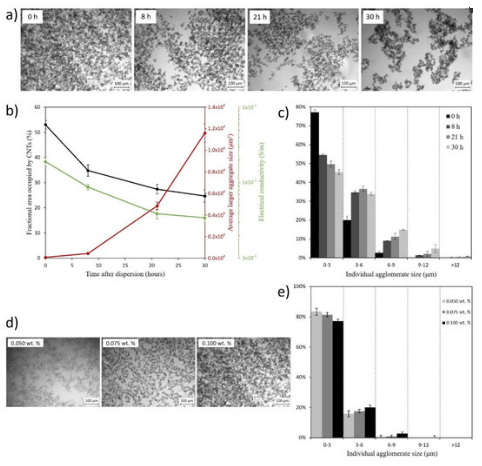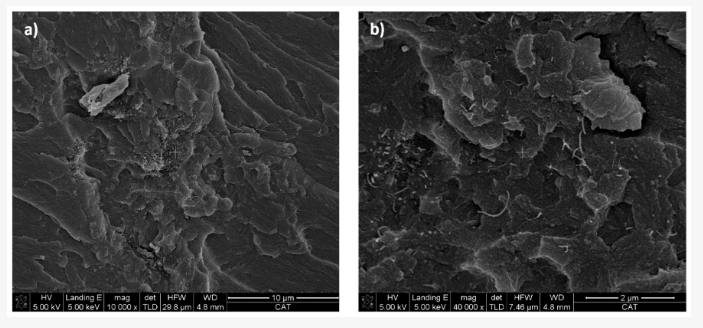Researchers from Spain continue the trend for the development of new combinations of materials, detailing their study in the recently published ‘Mechanical and Strain-Sensing Capabilities of Carbon Nanotube Reinforced Composites by Digital Light Processing 3D Printing Technology.’
While there have been numerous studies regarding carbon nanotube (CNT) reinforced composites—from improving materials to creating sensors for wearables, to e-textiles, and much more—here, the authors perform a more unique study regarding mechanical properties and strain sensors, with the ‘development of a conductive ink for DLP 3D printing technology with self-sensing capabilities based on a commercial photocurable resin doped with CNTs.’
Noting that 3D printing is making huge impacts within the industrial world, and in many other applications too, the authors state quite accurately that there is ‘a wide field for improvement.’
Composites are becoming increasingly popular in the 3D printing arena as users on all levels are able to meet their needs better for varying research, projects, and manufacturing of stronger parts.
“In particular, carbon nanotube (CNT) doped resins has been the subject of numerous studies in the last decades due to their great mechanical, thermal, and electrical properties,” state the researchers. “Their addition in low contents into an insulator resin allows the formation of electrical percolating networks inside the material, leading to an increase in electrical conductivity of the material of several orders of magnitude.”
Structural health monitoring (SHM) is a primary application able to benefit from such materials, as sensors can detect strain damage in metallic gauges. Previously, a variety of 3D printing studies have involved CNTs as fillers in developing parts with electrical properties, elastic strain sensors, shielding devices, and flexible electronics.
In this study, the researchers varied CNTs as they assessed the effects on conductivity. Next, the potential for strain sensing was investigated as the authors evaluated the impacts of load state and post-curing treatments.
A B9Creator was used for 3D printing six samples for the study with CNT content of 0.030, 0.050, 0.075, 0.100, and 0.150 wt %.
“The most relevant printing parameters were 30 µm of layer thickness and 5.12 s of exposure time per layer, except for those specimens with a 0.150 wt % CNTs, where the exposure time was increased to 6.84 s,” stated the authors.
“This is due to the higher CNT content that induces a more prevalent UV light shielding effect caused by CNTs, reducing UV radiation exposure of the photoinitiator and leading thus to an underexposure condition. On the other hand, overexposure conditions were observed for specimens with CNT contents below 0.100 wt % and longer UV light exposure times than 5.12 s.”
Half of the samples were subjected to UV post-curing treatments as the researchers studied the influence on strain sensing and mechanical properties.

Examples of 3D printed parts with 0.100 wt % CNT. (a) Tensile and three-point bending test specimens and (b) complex geometry parts.
DSC samples were also taken for ‘representative results’ as the researchers considered variances in curing degrees of each specimen.
The researchers confirmed that 3D printing is advantageous in this case as nanoparticles are dispersed in resin quickly. With a time delay, greater loss of properties is possible due to re-agglomeration of nanoparticles.

Changes on the dispersion state as a function of time after dispersion process was performed and as a function of CNT content. (a) TOM micrographs of dispersion containing 0.100 wt % CNT at 0, 8, 21, and 30 h after dispersion was carried out; (b) fractional area occupied by CNTs, average larger aggregate size and their influence in electrical conductivity as a function of time since after dispersion; (c) individual agglomerate size as a function of time after dispersion; (d) TOM micrographs at 0 h after dispersion as a function of CNT content; and (e) individual agglomerate size at 0 h after dispersion as a function of CNT content.

FEG-SEM micrographs showing CNTs distribution of the 0.100 wt % CNT specimen at (a) low magnifications and (b) high magnifications.
The evaluation showed that a suitable CNT distribution was reached with a lower electrical percolation threshold, and in terms of mechanical properties, increased material stiffness.
“Nevertheless, the best results in terms of strain sensitivity were also found for the lowest CNT contents since they are closer to the percolation threshold, with the tunneling effect being the most dominant mechanism of electrical charge transport. Moreover, strain sensitivity was found to be significantly lower for three-point bending tests than for tensile tests as expected because of the effect of the compression-subjected face on the whole electrical resistance of the specimen,” concluded the researchers.
“Therefore, the results prove the excellent capabilities of CNT reinforced DLP-manufactured nanocomposites in strain-sensing applications and shed light into how an UV post-curing treatment and CNT content affects the electromechanical properties of these materials.”
What do you think of this news? Let us know your thoughts! Join the discussion of this and other 3D printing topics at 3DPrintBoard.com.
[Source / Images: ‘Mechanical and Strain-Sensing Capabilities of Carbon Nanotube Reinforced Composites by Digital Light Processing 3D Printing Technology’]
Subscribe to Our Email Newsletter
Stay up-to-date on all the latest news from the 3D printing industry and receive information and offers from third party vendors.
You May Also Like
3D Printed Heat Spreader Could Improve Efficiency of Electronics
The low-hanging fruit for decarbonization has long been improving the efficiency of existing systems, hence the justification for LED lights and ENERGY STAR certified appliances. While such minor moves are...
3D Printing News Unpeeled: Marine Gearboxes, 3D Printed Motors and $1.7 Million in Seed Funding
UK based Equipmake just released their Ampere-220 e-axle system. The system, which is meant for high performance electric cars, was similar to one released on the Ariel HIPERCAR. It has...
CEAD Unveils 36-Meter-Long 3D Printer for Abu Dhabi’s Al Seer Marine
CEAD, a Dutch original equipment manufacturer dedicated to large-format 3D printers, has unveiled what it claims to be the world’s largest robotic arm-based 3D printer. At 36 meters long and...
3D Printed Biocomposites Could Help Reduce Marine Plastic Pollution
Concerns about the impact of plastic litter and microplastics in the oceans are at the forefront of environmental study. For decades, the marine environment has suffered from the degradation of...






































